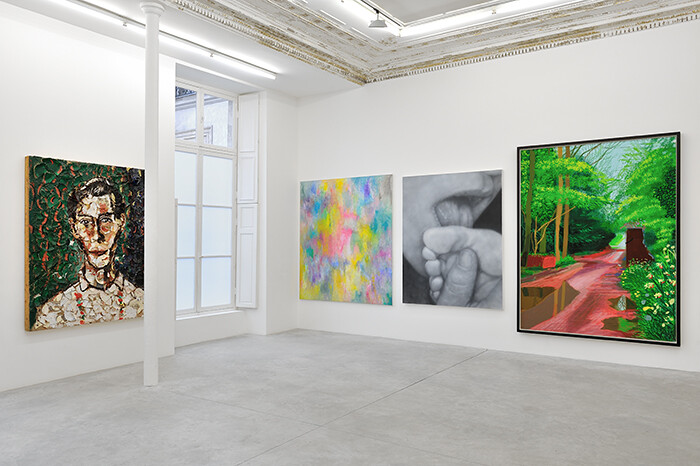In 1991, in response to critiques of his exhibition “No Man’s Time” at Villa Arson in Nice, curator Éric Troncy wrote a letter to the editors of Flash Art, in which he argued that the exhibition had been “based on no particular concept,” thus locating it outside of any theoretical framework. Instead, he positioned the show in proximity to Guy Debord’s idea of the spectacle, at least insofar as the viewer was presented with a spectacular kind of art—political, according to the curator, simply due to its negation of the heavily theoretical objectives and attitudes of galleries and institutions at the time. But in its apparent insurgency, Troncy’s radicalism seemed to belong solely to the leisure class, soliciting a conflation of art and life, which advocated a liberation from ideology, yet irrevocably gave way to a perverse commodification of the self.
Whilst it may seem uncalled for to hold Troncy to objectives declared over two decades ago, it is difficult to consider his recent exhibition at Almine Rech, “The Shell (Landscapes, Portaits & Shapes),” without being influenced by its resonances on the curator’s former conceptual approach. The exhibition, saturated with 42 paintings and a singular sculpture (a polyester caveman titled Giant, by Katarina Fritsch [2007]), aims to consider the medium outside of genre, period, or context. To achieve this, Troncy employs a panoramic display, presenting the works side-by-side in close configuration—the effect being a leveling of distinctions between discrete pieces and their concomitant histories. The works, in other words, are uncoupled from their original contexts, rendering any particular content or message irrelevant. The more paintings are included in the exhibition, the less of an impact each individual work can make. Instead, they become viewed as mere contributions to a larger pool of thought—a circulatory system of art, which negates individuation for the purpose of abundance, production, or accumulation. This approach not only neutralizes the works from any historical potency, but is also quite profoundly depoliticizing in its total failure to acknowledge the social, political, or even aesthetic differences present. Painting, within this context, becomes little more than an object of conspicuous leisure—a pretty picture with an exchange value.
Even more problematic, however, is that Troncy not only strips the paintings from a past potency in favor of accentuating their entertainment value, but also to an extent dismisses their future reception as anything but. In order to compensate for the lack of distinction, Troncy’s curatorial method employs a spectacular display that relies on the emphasis of newness to create impact in “unexpected” or “accidental” pairings between historic and young artists. It isn’t difficult, for example, to imagine the juxtaposition of Julien Schnabel’s painted tarpaulin The Day I Missed (1990) and David Ostrowski’s abstraction F (dann lieber nein) (2014)—yet here, they are framed as a novel and surprising interaction that is purely contingent on curatorial precociousness. Moreover, in the press release accompanying the exhibition, Troncy muses that “to the new generations, art from the past few decades may present itself as a Tumblr, a panoramic view with uninhibited entertainment virtues.”1 As this is framed as a curatorial policy, not only does it come off as disturbingly patronizing towards younger, critical viewers, but it also strongly seems to suggest—in what seems a optimistic tone, mind you—that the potential to question artistic convention may be lost to future generations.
In this, perhaps the counter-theorizing ideologies that permeated “No Man’s Time” still hold high rank in Troncy’s curatorial index. So much so, in fact, that it is arguable whether it is a mere coincidence that in John Welchman’s Art After Appropriation (2001), one finds a discussion of Troncy’s aforementioned 1991 exhibition, preluded by a description of practices in the early 1990s that were “viewed outside the shell of any theoretical dependence—or even, at the extreme of this tendency, beyond reference itself.”2 If this holds true, and Troncy’s intent is to liberate painting from its “shell” of references, then why hold on fastidiously to a model that only reinforces immediate—though not necessary accurate—cross-referencing between the works themselves?
Troncy’s model brings into close proximity, for example, Jonas Wood’s quirky interior, Landscape Pot 2 (2014), Jean-Baptiste Bernadet’s abstraction Untitled (Vetiver IV) (2014), John Currin’s Dream of the Doctor (1997), and Bridget Riley’s Aria (Azure) (2013–14). Again, the irreverent mismatching of background and context not only negates the possibility of understanding the works, but legitimizes Troncy’s suggestion that they need not be understood. That is, the connections established within the rooms seem, at best, like obvious visual parallels—the reticent formalism of Erik Lindman’s Untitled (2014) closely framed by Bertrand Lavier’s Walt Disney Productions #21 (2014)—or, at worst, meaningless connections that emerge out of the sheer human impulse to find them. This is not to say that the exhibited works lack common ground; on the contrary, there is something inadvertently astute and cohesive about the selection: the exhibition can be considered as a survey of the past few decades in painting, which follows through the changes imposed on the media through its circulation. But whatever meaningful discourse could have emerged, particularly from such a comprehensive selection of painting from recent history, is negated by the curatorial choices made by Troncy, who clearly still prefers a spectacular model of production over a critical reconstruction, even if that spectacle is now far from what Debord intended.
Eric Troncy, The Shell (Landscapes, Portraits and Shapes). Press release, Almine Rech, 2015.
John Welchman, Art After Appropriation: Essays on Art in the 1990s (London: Routledge, 2001), 31.









